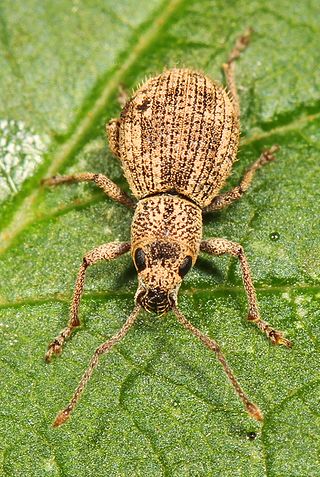
Gagea is a large genus of spring flowers in the lily family. It is found primarily in Eurasia with a few species extending into North Africa and one species in North America.

Aelurillus is a genus of spiders in the family Salticidae.
Mogrus is a genus of jumping spiders that was first described by Eugène Louis Simon in 1882.

Alopecosa is a spider genus in the family Lycosidae, with about 160 species. They have a largely Eurasian distribution, although some species are found in North Africa and North America.

Drassodes is a genus of ground spiders that was first described by Niklas Westring in 1851. They are brown, gray, and red spiders that live under rocks or bark in mostly dry habitats, and are generally 3.8 to 11.6 millimetres long, but can reach up to 20 millimetres (0.79 in) in length.

Amberboa is a genus of flowering plants in the tribe Cardueae within the family Asteraceae, described as a genus in 1832.

Galeodes is a genus of solifuges or sun spiders. The nearly 200 species in this genus are found in northern Africa, southeastern Europe and Asia. Like other solifuges, they are mainly nocturnal and found in arid habitats. They often have long hairy appendages and are not as stout bodied or dark and contrastingly coloured as some other solifuges. Some Galeodes species are able to produce sounds by stridulation. These are usually raspy or hiss-like and may be imitations of the sounds of vipers, to serve a defensive function. As in other solifuges, mating involves the male depositing a spermatogonia that is manipulated into the female genital opening using their chelicera. The male strokes the female using the palps allowing her to be approached. Females will often feed on males before or after mating. The female then deposits the eggs in a burrow in soil and in some species guards them.

Ethmia vittalbella is a moth in the family Depressariidae. It is found on Morocco, Tunisia, Algeria, Libya, Egypt, Jordan, Arabia, Armenia, Turkmenistan, Uzbekistan, Kazakhstan, Iran, Iraq, Syria, Afghanistan, Pakistan, India and Russia.

Cyphicerini is a tribe of oriental broad-nosed weevils in the subfamily of beetles known as Entiminae.
Tanymecini is a tribe of broad-nosed weevils in the beetle family Curculionidae, subfamily Entiminae.

Rhinusa is a genus of true weevils in the family of beetles known as Curculionidae. There are at least 20 described species in Rhinusa.

Lepyrus is a genus of true weevils in the beetle family Curculionidae. There are more than 70 described species in Lepyrus.

Anthrenus is a subgenus of the genus Anthrenus of the subfamily Megatominae within the family of skin beetles.

Anthrenus pimpinellae complex is a group of closely related species from subgenus Anthrenus. Most species that currently belong to the group were previously assigned as subspecies of Anthrenus pimpinellae.

Metapion squamosum is a species of weevil in the family Brentidae. The species is generally known from Central Asia in countries such as Kazakhstan, Tajikistan, Turkmenistan and Uzbekistan but also appears in parts of Caucasus region. Some sources mention presence in Libya.












